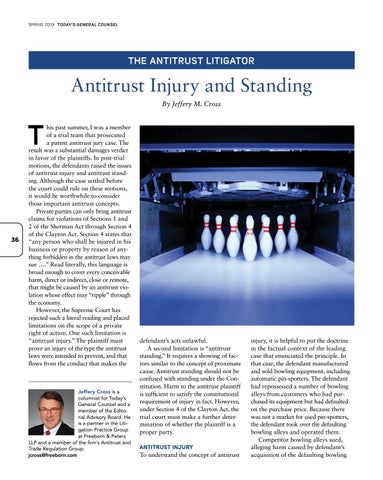SPRING 2019 TODAY’S GENER AL COUNSEL
THE ANTITRUST LITIGATOR
Antitrust Injury and Standing By Jeffery M. Cross
T
36
his past summer, I was a member of a trial team that prosecuted a patent antitrust jury case. The result was a substantial damages verdict in favor of the plaintiffs. In post-trial motions, the defendants raised the issues of antitrust injury and antitrust standing. Although the case settled before the court could rule on these motions, it would be worthwhile to consider those important antitrust concepts. Private parties can only bring antitrust claims for violations of Sections 1 and 2 of the Sherman Act through Section 4 of the Clayton Act. Section 4 states that “any person who shall be injured in his business or property by reason of anything forbidden in the antitrust laws may sue ….” Read literally, this language is broad enough to cover every conceivable harm, direct or indirect, close or remote, that might be caused by an antitrust violation whose effect may “ripple” through the economy. However, the Supreme Court has rejected such a literal reading and placed limitations on the scope of a private right of action. One such limitation is “antitrust injury.” The plaintiff must prove an injury of the type the antitrust laws were intended to prevent, and that flows from the conduct that makes the
Jeffery Cross is a columnist for Today’s General Counsel and a member of the Editorial Advisory Board. He is a partner in the Litigation Practice Group at Freeborn & Peters LLP and a member of the firm’s Antitrust and Trade Regulation Group. jcross@freeborn.com
defendant’s acts unlawful. A second limitation is “antitrust standing.” It requires a showing of factors similar to the concept of proximate cause. Antitrust standing should not be confused with standing under the Constitution. Harm to the antitrust plaintiff is sufficient to satisfy the constitutional requirement of injury in fact. However, under Section 4 of the Clayton Act, the trial court must make a further determination of whether the plaintiff is a proper party. ANTITRUST INJURY
To understand the concept of antitrust
injury, it is helpful to put the doctrine in the factual context of the leading case that enunciated the principle. In that case, the defendant manufactured and sold bowling equipment, including automatic pin-spotters. The defendant had repossessed a number of bowling alleys from customers who had purchased its equipment but had defaulted on the purchase price. Because there was not a market for used pin-spotters, the defendant took over the defaulting bowling alleys and operated them. Competitor bowling alleys sued, alleging harm caused by defendant’s acquisition of the defaulting bowling

